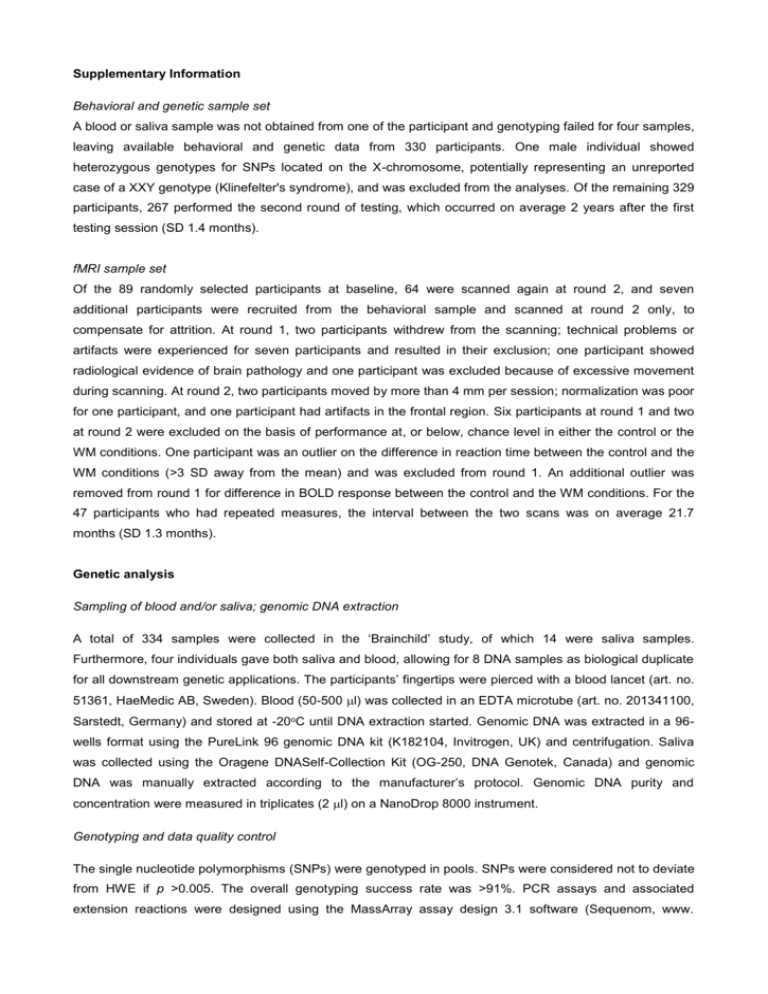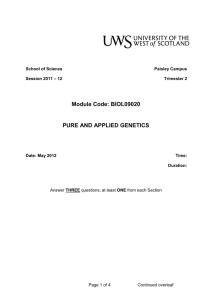Supplementary Information Behavioral and genetic sample set A
advertisement

Supplementary Information Behavioral and genetic sample set A blood or saliva sample was not obtained from one of the participant and genotyping failed for four samples, leaving available behavioral and genetic data from 330 participants. One male individual showed heterozygous genotypes for SNPs located on the X-chromosome, potentially representing an unreported case of a XXY genotype (Klinefelter's syndrome), and was excluded from the analyses. Of the remaining 329 participants, 267 performed the second round of testing, which occurred on average 2 years after the first testing session (SD 1.4 months). fMRI sample set Of the 89 randomly selected participants at baseline, 64 were scanned again at round 2, and seven additional participants were recruited from the behavioral sample and scanned at round 2 only, to compensate for attrition. At round 1, two participants withdrew from the scanning; technical problems or artifacts were experienced for seven participants and resulted in their exclusion; one participant showed radiological evidence of brain pathology and one participant was excluded because of excessive movement during scanning. At round 2, two participants moved by more than 4 mm per session; normalization was poor for one participant, and one participant had artifacts in the frontal region. Six participants at round 1 and two at round 2 were excluded on the basis of performance at, or below, chance level in either the control or the WM conditions. One participant was an outlier on the difference in reaction time between the control and the WM conditions (>3 SD away from the mean) and was excluded from round 1. An additional outlier was removed from round 1 for difference in BOLD response between the control and the WM conditions. For the 47 participants who had repeated measures, the interval between the two scans was on average 21.7 months (SD 1.3 months). Genetic analysis Sampling of blood and/or saliva; genomic DNA extraction A total of 334 samples were collected in the ‘Brainchild’ study, of which 14 were saliva samples. Furthermore, four individuals gave both saliva and blood, allowing for 8 DNA samples as biological duplicate for all downstream genetic applications. The participants’ fingertips were pierced with a blood lancet (art. no. 51361, HaeMedic AB, Sweden). Blood (50-500 l) was collected in an EDTA microtube (art. no. 201341100, Sarstedt, Germany) and stored at -20oC until DNA extraction started. Genomic DNA was extracted in a 96wells format using the PureLink 96 genomic DNA kit (K182104, Invitrogen, UK) and centrifugation. Saliva was collected using the Oragene DNASelf-Collection Kit (OG-250, DNA Genotek, Canada) and genomic DNA was manually extracted according to the manufacturer’s protocol. Genomic DNA purity and concentration were measured in triplicates (2 l) on a NanoDrop 8000 instrument. Genotyping and data quality control The single nucleotide polymorphisms (SNPs) were genotyped in pools. SNPs were considered not to deviate from HWE if p >0.005. The overall genotyping success rate was >91%. PCR assays and associated extension reactions were designed using the MassArray assay design 3.1 software (Sequenom, www. sequenom.com). Primers were acquired from Metabion GmbH (Planegg-martinsried, Germany). Amplification reactions were run in a total volume of 5 μL with 10 ng of genomic DNA and 1 pmol of the amplification primer, 100 nM of each deoxynucleotide triphosphate, 1.625 mM of MgCl2, and 0.5 U of HotStarTaq DNA polymerase (Qiagen, Crawley, West Sussex, United Kingdom). Reactions were heated at 95°C for 15 min. and thereafter subjected to 45 cycles of amplification (20 s at 94°C, 30 s at 56°C, 60 s at 72°C) prior to a final extension of 3 min. at 72°C. Unincorporated dNTPs were dephosphorylated by addition of 0.3 U shrimp alkaline phosphatase (SAP). Extension reactions were carried out in a total volume of 9 μL using 0.62 5μM to 1.25 μM extension primer and the Iplex Gold Reagents Kit Clean primer extension products were analyzed by a MassARRAY mass spectrometer (Bruker Daltonik GmbH, Bremen, Germany). The SpectroT RT3.3.0/4.0 software (Sequenom) was utilized to analyze the resulting mass spectra for peak identification. 2







